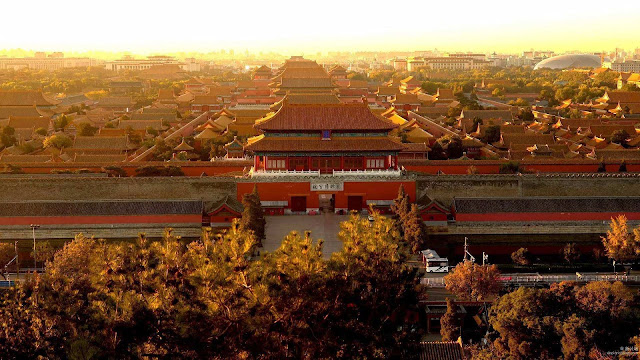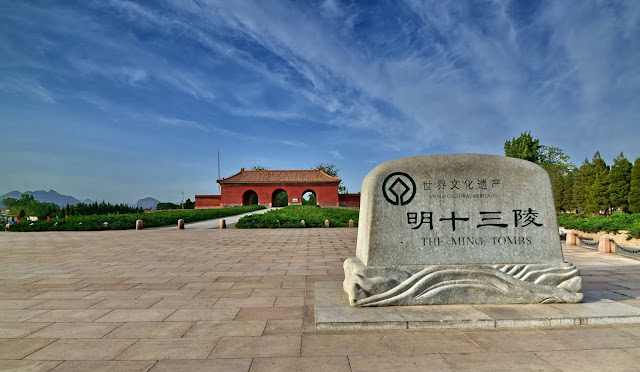Top 10 tourist attractions in Beijing, China
 |
| Beijing Tiananmen Square |
一、Beijing Palace Museum
The Palace Museum is a comprehensive Chinese museum established on the basis of the imperial palaces and collections of the Ming and Qing dynasties. It is located in the center of Beijing, with Tiananmen Square in front, Jingshan Mountain in the back, Wangfujing Market in the east and Zhongnanhai in the west. In 1961, with the approval of the State Council, the Forbidden City was designated as the first batch of key cultural relics protection units in the country. In 1987, the Forbidden City was included in the "World Cultural Heritage" list by UNESCO. According to ancient Chinese astrological theory, Ziweiyuan (the North Star) is located in the middle of the sky. It is the residence of the emperor of heaven and corresponding to the heaven and man. It is also called the Forbidden City because of the emperor's residence. After taking the throne, Zhu Di, the third emperor of the Ming Dynasty, decided to move his capital to Beijing and began to build this palace. It was completed in the 18th year of Yongle in the Ming Dynasty (1420). In 1911, the 1911 Revolution overthrew China's last feudal monarchy, the Qing Dynasty, and in 1924, Emperor Xun Puyi was expelled from the palace. During the five hundred years, a total of 24 emperors lived here and ruled the country. The Forbidden City is surrounded by a city wall 10m high and a moat 52m wide. The city is 961m long from north to south and 753m wide from east to west, covering an area of 780,000 square meters. There is one gate on each of the four sides of the city wall. The Meridian Gate in the south and the Shenwu Gate in the north are now exclusively for visitors to visit. The architectural layout of the palaces in the city spreads out to the east and west along the central axis. The red walls and yellow tiles, painted and carved beams, are magnificent. The halls and terraces are staggered and magnificent. In the morning and evening, it is like a fairyland on earth. The southern half of the city is centered on the three halls of Taihe, Zhonghe, and Baohe. On both sides, the two halls of Wenhua and Wuying are supplemented by the emperor... [detailed]二、Beijing Badaling-Mutianyu Great Wall Tourist Area
The Great Wall is famous at home and abroad. There are great walls in many places in China. The most famous one in China is the Badaling Great Wall, and the most famous one abroad is the Mutianyu Great Wall. The Badaling Great Wall is located at the north entrance of Guangou Ancient Road, Jundushan, Yanqing District, Beijing. It is an important part of the Great Wall of China, a great defense project in ancient China, and a pass of the Ming Great Wall. The Badaling Great Wall is an important outpost of Juyong Pass. It was called "The danger of Juyong is not in the pass but in Badaling". The Badaling Great Wall is the earliest section of the Ming Great Wall that was opened to tourists. In March 1961, the "Great Wall-Badaling" was identified as the first batch of national cultural relics protection units. In 1961, the State Council designated the Badaling Pass and the city wall as a national key cultural relics protection unit. It was listed as a national key scenic spot in 1982; Badaling, as an important part of Beijing's Badaling-Mine Tombs scenic spot, was approved by the State Council to be included in the first batch of national-level scenic spots. In 1986, Badaling was named one of the sixteen scenic spots in the new Beijing and the top ten scenic spots in the country. It was included in the "World Cultural Heritage List" by UNESCO in 1987. In August 1991, Badaling, as the essence of the Great Wall of China, received the Human Cultural Heritage Certificate issued by UNESCO at the Palace Museum in Beijing. In December 1991, at the naming convention of the forty best tourist attractions in China held in Zhuhai (94 candidate scenic spots nationwide, 480,000 valid votes were collected), Badaling was famous for its scenic spots, with an absolute number of 370,000. The number of votes has become the top forty tourist attractions in China. Was...[detailed]三、Beijing Temple of Heaven Park
The Temple of Heaven is in the southeast of Beijing, on the east side of Yongdingmennei Street, Chongwen District. Covering an area of about 2.7 million square meters, it is the largest surviving ancient ritual building complex in China. Today, the Working People’s Cultural Palace on the east side of Tiananmen Square is the place where the emperor worshipped his ancestors, and the Zhongshan Park on the west side is where the god of harvest, the god of harvest, is worshipped. In the entire city of Beijing, there is an altar of earth in the north, an altar of heaven in the south, an altar of heaven in the east, an altar of sun in the east, and a moon altar in the west. The temple of heaven is the most dazzling and extraordinary. The Temple of Heaven was built in the eighteenth year of Yongle in the Ming Dynasty (1420), and was rebuilt during the Qianlong and Guangxu periods of the Qing Dynasty. It is a place for the emperors of Ming and Qing dynasties to worship the emperor and pray for abundance of grains. The Temple of Heaven is the general name of the two altars of Qiuqiu and Qigu. There are two altar walls to form an inner and outer altar. The altar wall is round in the south and north, symbolizing the place where the sky is round. The main building is the inner altar, the Qiu altar in the south and the Qigu altar in the north. The two altars are on the same north-south axis, separated by a wall. The main buildings in the Qiuqiu altar include the Qiuqiu altar and the imperial dome, etc. The main buildings in the Qigu altar are the Hall of Prayer for Good Harvests, the Hall of Emperor God, and the Gate of Prayer for Good Harvest. The famous Hall of Prayer for Good Harvests is in the far north. This is the most magnificent and gorgeous building in the Temple of Heaven, and it is also the place closest to the sky in imagination. The upper and lower three-story roofs of the Hall of Prayer for Good Harvests are covered with dark blue glazed tiles, symbolizing the sky. Except for the Tai Chi stone in the center, which is round, each circle is fan-shaped, and the number is also positive, symbolizing the nine heavens. The tablet of the emperor is placed on the Tai Chi stone, which symbolizes that the emperor is above the nine heavens. The annex buildings of the Qiqiu altar include the Emperor Dome and the Echo Wall. If the Tiananmen Gate Tower has become a symbol of China, then the Temple of Heaven Praying Hall is...[detailed]四、Summer Palace, Beijing, China
五、Beijing Old Summer Palace Relic Park
六、Ming Tombs Scenic Area, Beijing, China
The Ming Tombs Scenic Area is a national-level scenic spot, a national AAAAA-level tourist attraction, a national key cultural relic protection unit, and a world cultural heritage.
The Ming Tombs is short for the tombs of the thirteen emperors and empresses of the Ming Dynasty. It is located in a small basin under Tianshou Mountain in Changping County, about 44 kilometers northwest of Beijing, covering an area of about 40 square kilometers. Drive straight down from Deshengmen and pass through Shahe and Changping north to reach the Ming Tombs.[detailed]






Comments
Post a Comment